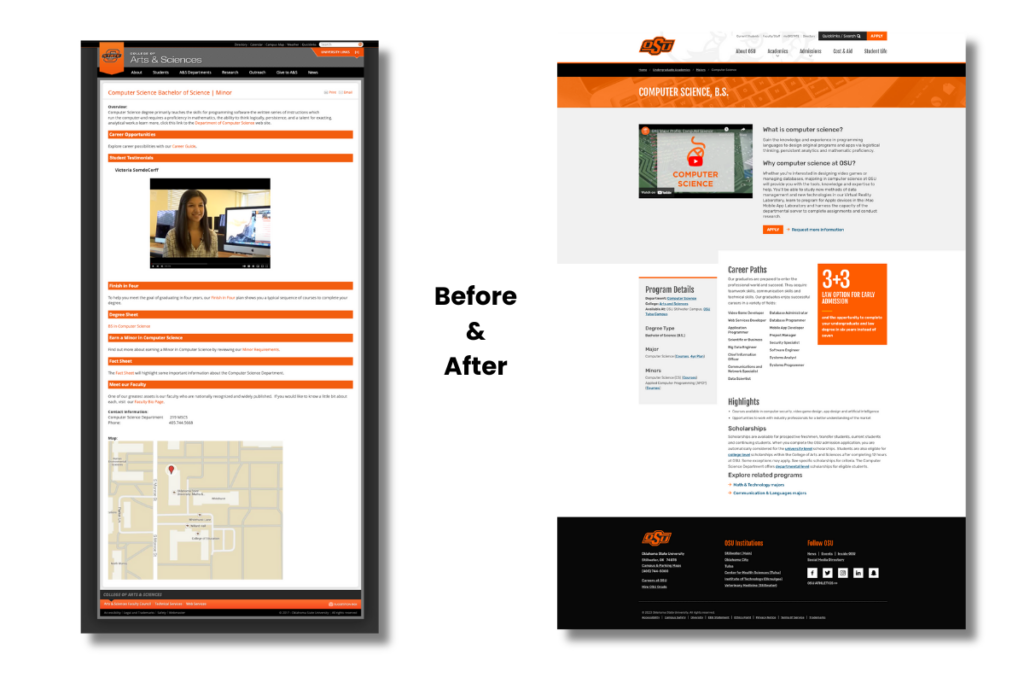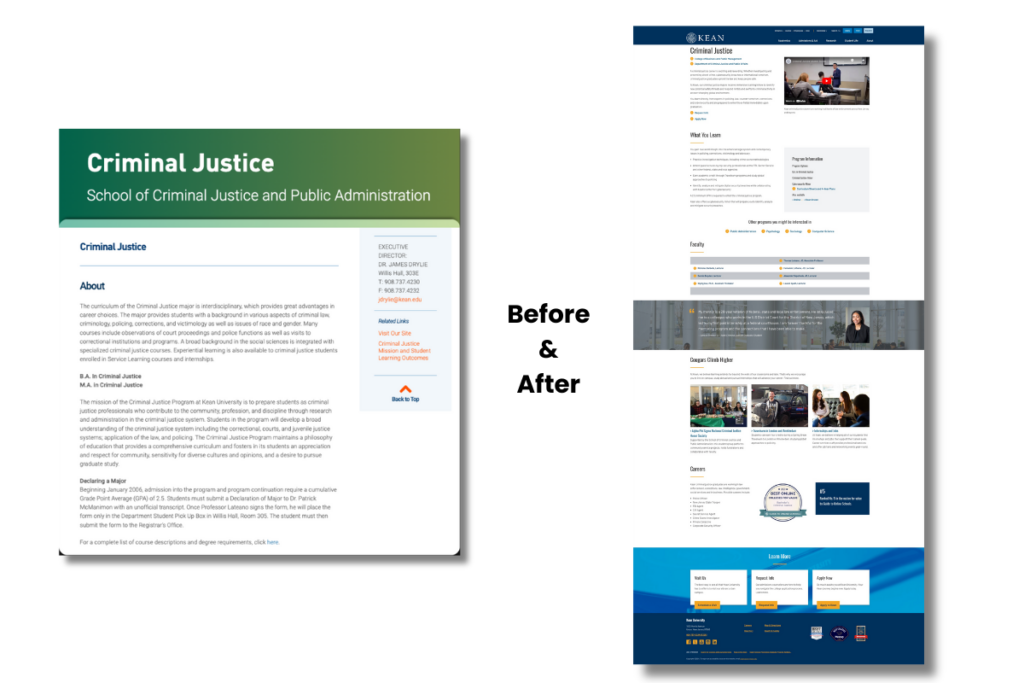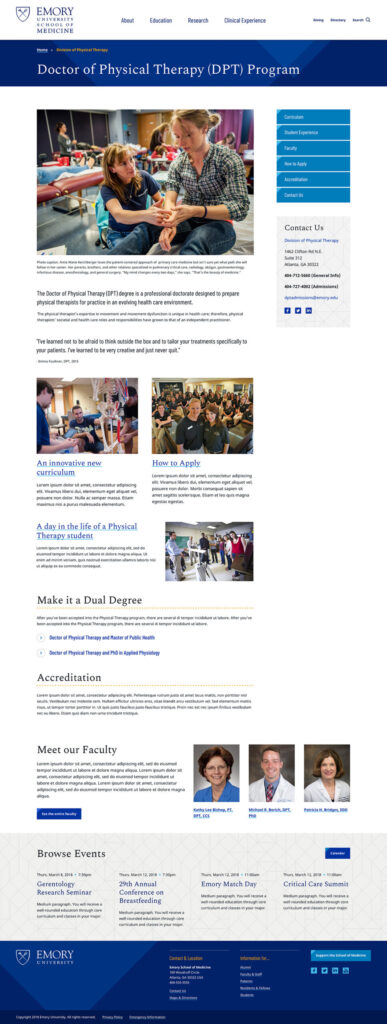In Part 1 of NewCity’s Seven Pillars of Higher Ed Digital Strategy, we explored how language and empathy helps higher ed teams build bridges and collaborate around a shared vision to drive enrollment success.
In part 2, we move into the practical application of strategy by breaking down how to meet your prospective student’s most important goal when visiting your website.
In our work with more than 50 institutions over three decades, NewCity has done a LOT of research with prospective students, from undergraduate to international to grad/professional and continuing ed. It’s no secret that the number one user goal on a higher ed website is “Do you have the degree program I want, and how does it compare?”
In higher ed, degree programs are your website’s product pages. Ecommerce companies put tremendous energy into their product pages, then they streamline everything that helps you browse, search, and compare to choose the product you want to buy.
In spite of this fact, we still see institutions putting more resources into other parts of their website and neglecting their degree programs. Making them great isn’t just a content challenge, it’s often a political one. Despite the difficulties, we encourage you to focus first and foremost on these pages.
Your institution itself is to some degree also the product. But you’re not going to get a chance to persuade a student about the school if you don’t impress them with the degree first.
In this article you’ll find:
- A case for an ongoing investment in your degree program pages as the hardest working pages on your site.
- Our recommendations, based on years of research, into how you can make your degree program pages inviting and powerful.
Why Focus on Degree Programs?
Degree programs are the top goal for prospective audiences, and form a powerful first impression.
If you look at your own analytics chances are 15% or more of the visitors will pursue academic programs as their next step. Degree programs are always in the top 3 goals for prospective audiences.
When we look at heat map data for engagement or observe students in usability tests, we see them:
- Form a quick first impression from the overall look of the home page.
- Scan the main navigation, then the rest of the page, looking for words like “Academics” or “Degrees” or “Majors” (“Courses” in the UK).
- Follow that trail through the site until they find the degree program they’re seeking.
We DON’T see them scroll leisurely down the page, stopping to read marketing messages or watch videos. They pay little attention to content on the home page or intermediate pages until they find this degree program page. Once they find it, they start trying to answer their top questions from the degree program landing page.
Bear in mind that their impression of your institution is being influenced by how painless this experience is. They won’t notice it unless it’s bad.
In our article From Clicks to Perception: How Top Tasks Shape Brand Experience we explore this idea further, and give a simple exercise you can do to see what impression your degree program pathways are giving your prospective audiences. Key takeaway? If someone comes to you on a mission, with a key question – answer their question! Help them accomplish their top task! Make that experience delightful and interesting. During or after accomplishing their top task, they’ll be open to your key brand messages.
The majority of degree program visits bypass the homepage.
If degree programs are the top goal for prospective students, how do they get there? Your analytics will show less than half of your visits to academic program content start on the home page. The rest are starting from a search engine, or clicking a link from an email, social post or a recommendation website.
We often see this search pattern: <degree program> in <geographic limiter>, like “top accounting programs in the northeast US”. The first page of results from this will most likely be aggregator sites that rank universities offering that degree program.
These ranking sites may link to your home page (Niche), but increasingly they try to keep you on their site to sell you their services (US News) and even want you to use their RFI form – yuck! (I’m looking at you College Factual).
So let’s say a student finds out you have a good accounting program through one of these sites, or they’ve heard it from a counselor/family member/friend. Now they search “accounting degrees at <your school name>”. This search is going to lead directly to the degree program landing page – not your home page.
Unfortunately a lot of schools still have two (or more) versions of their degree program pages: one created by the admissions team, one on the academic department website, and maybe another coming from the catalog. Google tends to prioritize the academic department’s version if there is more than one.
So it’s important not only to create great degree program pages, but to persuade people you should have only one version.
What makes a great degree program experience?
Journeys that reflect the nature of the degree
The decision process for students can vary a lot depending on the specific degree. For example:
- A student pursuing a BS in engineering may not know yet where they want to specialize. They need an overview of the engineering program and then some content that helps them see the differences between mechanical, aerospace, electrical, industrial etc.
- A student seeking a graduate degree in a research field will want to know about specific faculty members’ research interests, lab facilities etc.
- Students pursuing a professional degree may be more focused on admission requirements, cost, time, and employment prospects.
- Some degree programs have special admission requirements like tests, auditions, portfolio reviews, etc.
Often there are several degrees that are similar or related, and a student may not know exactly which one they want. So part of this journey may be showing them this group of similar degrees, and helping them understand the nuances and differences between them before they focus on one. Many schools group related degree programs under a broad subject, even if they’re offered by different departments and colleges.
Answering students’ top questions about the degree
These are the questions every degree program landing page should answer:
- What is the degree in _____ like here?
- How is it better than or distinct from similar degrees at other institutions?
- What sort of things will I learn each year? (curricular highlights)
- Is there anything I recognize that seems familiar from what I’ve done or what I’ve heard you can do with this degree?
- Does it sound interesting? Exciting? Challenging? Practical?
- Does this degree have special entry requirements?
- What do I need to apply?
- What do other students think about it?
- What are the faculty members like?
- What sort of student activities could I get involved in related to this degree?
- What sort of career opportunities will I really have? What have graduates gone on to do? How will it do a better job preparing me for my career or connecting me to opportunities?
Obviously you may not answer all of these questions on one page, often there are links to supporting pages.
As people seek answers to these specific questions about the degree program, they’re also forming an impression about these key choice factors:
- What are my chances of getting in?
- How would I fit in there? Are there faculty and students who look like me there?
- What’s it like to be a student there?
- Is it in a place where I’d like to be?
- What makes this institution special?
Realize students aren’t just taking your word for it. They look to a lot of other sources, especially to get the real story of the student experience. It’s always changing, but today we see them turning to Reddit, Youtube (“Day in the Life <college name>”), Tiktok, and Instagram. How that factors into your marketing strategy is a whole other topic.
Scannable and visually interesting page layouts
How you present this content will also have an impact on whether people read it and what impression it leaves. It’s great to have a visually interesting template for your degree programs, even better to have flexible layout patterns in your design system so you can adapt to any specifics of a degree program.
If you do nothing else, edit your text to break up paragraphs for easier readability (not more than 50-75 words), use subheads and bullet lists to make content easier to scan.
Examples We Love
OSU Computer Science Degree Page
- Consolidating degree programs in the main site rather than on each college site actually increased traffic to colleges and depts.
- Most recent enrollment year 2.6% increase in YoY enrollment from 2023- adding 500 students.
Kean Criminal Justice Page
- After a recent refresh from an earlier version of site we had done for them, pages per session grew significantly and bounce rates decreased dramatically.
Emory School of Medicine
- Emory SOM Doctor of Physical Therapy Page provides good examples of supporting content for a professional degree, including paths to Curriculum, How to Apply, Day in the Life and Student Testimonials.
Getting There from Here
You may already be convinced of the importance of your degree program pages, but if your institution is like most, the path to improve them involves a lot of work, committee meetings, experts, opinions, and revisions. It’s not something you can just outsource to a marketing firm.
Our approach once we understand the landscape is to:
- Conduct and gather research into a school’s target students and their questions.
- Design a process to get information from faculty and department leadership with a minimum of homework.
- Start with those departments most enthusiastic about participation.
- Develop a detailed content work plan for all of the degree programs, with estimated hours to inform budgets and timelines.
- Coordinate the editing work across a group of content specialists who understand the prospective student audience.
- Track and measure the effectiveness of new degree program pages as we roll them out.
It’s hard work, no question. But there’s nothing more satisfying than seeing interest and applications climb for the first cohort of programs. We’ve seen other departments lining up to be next after hearing about these early wins.
The results we’ve seen across many partnerships gives us confidence to say that degree program pages are the most important pages in a content strategy that supports enrollment. Getting these right, investing in them, optimizing them and sharing their success can pave the way for improved digital strategy across your entire web presence.
This is what we do, so if you’re looking for a collaboration partner or just some guidance, talk to us.
We’d love to hear from you.




